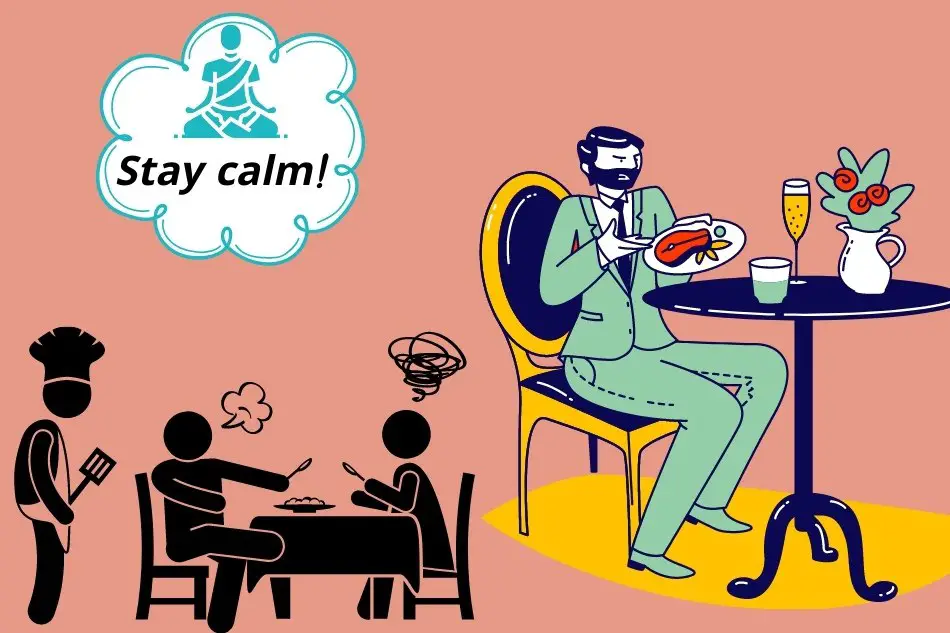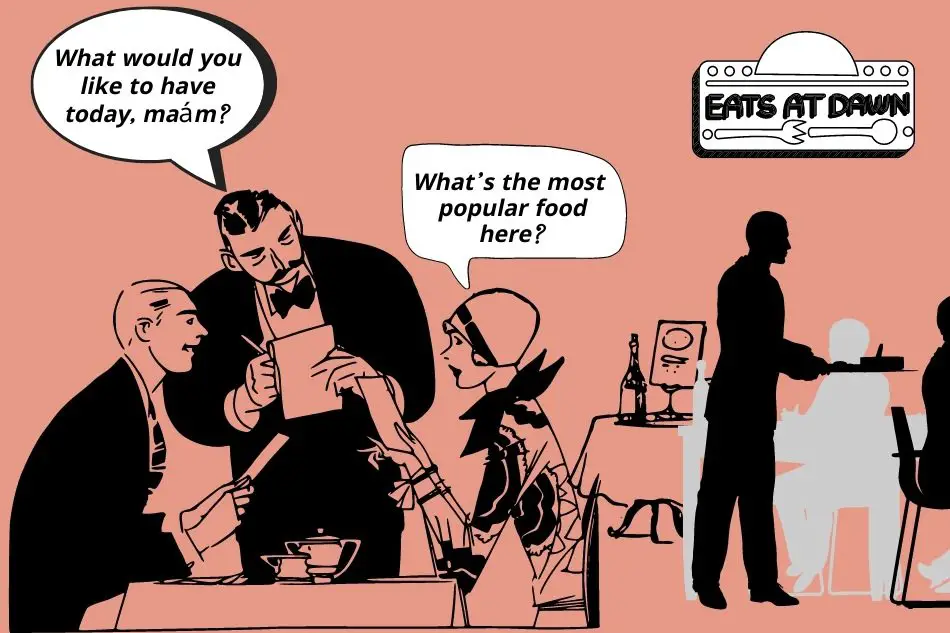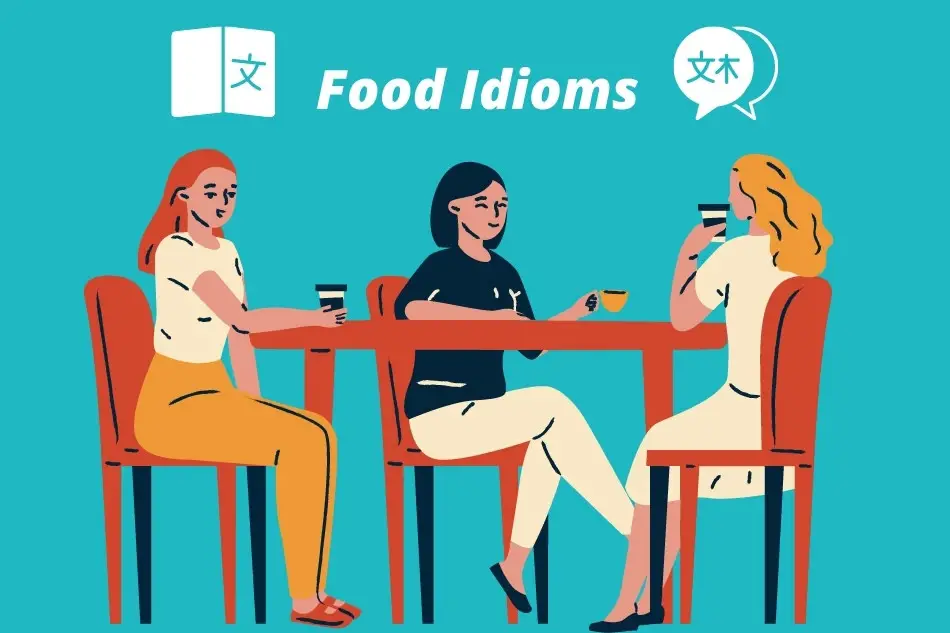Ordering food in English at a restaurant may seem terrifying to some of us. However, knowing appropriate expressions and culturally appropriate etiquette will undoubtedly help you. No worries! In this post, I’ll share some expressions & tips that will help you confidently order food in English at a restaurant.
To order any food in English at a restaurant, you can say, for example, “Can I have a large pepperoni pizza, please?” Be specific and clear about any special requirement, and appreciate the suggestions from the server. Being polite and thankful to the server while ordering food in a restaurant can bring you the best service.
Are you looking for a book or a guide to help you learn and improve your English? You may try English Made Easy Volume One: A New ESL Approach: Learning English Through Pictures (Amazon Link).
Table of Contents
- A List of Expressions to Order Food in English at a Restaurant
- Greet the Server Back and Share Your Table Requirement
- Be Polite in Your Words, Gesture, and Tone
- Appreciate Any Suggestions from the Server
- Be Specific and Clear about Your Orders
- Talk about Special Considerations (If Any)
- A Conversation Between a Server and a Customer at a Restaurant
- Idioms Related to Food Items
- A Sample Conversation on Ordering Food at a Restaurant
- Takeaway Words
- In Conclusion
- 10 Frequently Asked Questions Related to Ordering Food in English at a Restaurant
Here, I present some expressions you can use to order food in English at a restaurant.
A List of Expressions to Order Food in English at a Restaurant
- Can I get a chicken sandwich, please?
- May I have a chocolate donut, please?
- Can I have a hamburger with extra cheese, please?
- May I get a coke, please?
- Could I have some chocolate ice cream, please?
- Could I get some oreo cookies with the coffee, please?
- Do you have shrimp creole?
- Can I order Spanish rice?
- May I order a key lime pie?
- I would like to have a cobb salad.
- I would like to order chicken fried steak.
- I’ll have a hotdog.
- Are nachos available now?
- How about Chicago-style pizza?
Remember! You can use these expressions mentioned above while you have your food sitting at the restaurant. If you prefer taking a parcel, you use the phrase “to go” or “take out.”
- Can I have this Philly cheesesteak to go, please?
- Can I get this beef sizzling? Take out?
Note: Some restaurants have both “take out” and “dine-in” services. Servers usually ask if your order is “for here” or “to go.” “For here” refers to “dine-in,” and “to go” refers to “take out.”
Besides the mentioned expression, there are some interesting common food idioms native English speakers use. I’ll share them in the latter part of the post. Also, at the end of the post, I’ll share a real conversation between a customer and a server at an American restaurant. Let’s move on.
Now, look at the following tips you might follow while ordering food at a restaurant.
Greet the Server Back and Share Your Table Requirement
It’s obvious that the restaurant people will greet you while entering the restaurant and ask you how they can help you. You are expected to greet the server back and politely ask for a table that fulfills your requirements.
You can say, for example, “I would like a table for six, please?” Now you can ask for the menu and proceed with the order if it has not been provided yet.
Be Polite in Your Words, Gesture, and Tone

Politeness is the key to a good conversation. No matter who you talk to in any context, be polite in your body language and tone. Say “yeah” or “yes” if you agree with the server regarding any menu or service, or you can just nod your head to show your consent.
Stay calm and gentle, even if there is any problem with the food or service. Talk to the server to try to solve the problem. And top of that, stay gentle so that other people are not disturbed by your behavior. Do you remember what an American president once said?
All great change in America begins at the dinner table.
Ronald Reagan
Appreciate Any Suggestions from the Server

Sometimes, you may get confused about which one to choose from the menu. In that case, you can ask for suggestions. Appreciate the suggestions and ask further questions about the food if needed. Also, respond to the questions from the server politely to enjoy the best food and service.
- What’s the most popular food here?
- Should I go for this one?
- What do you suggest?
- I would like to have vegan items. Which one do you suggest?
- Does this pizza have both chicken & beef?
Be Specific and Clear about Your Orders
While ordering food at a restaurant, be very specific about the items you pick from the menu. Since it’s pretty common to have a conversation about several items between you and the server, s/he may get confused. Clarify the items’ names and reconfirm before the server leaves if he does not do so.
To respond to the reconfirmation of the server, you can say
- Yes, that’s all. Thanks.
- Yeah, that’s it. Thank you.
Talk about Special Considerations (If Any)
People have different preferences regarding their food habits. Some like chicken, others like beef; one prefers less cheese, another extra. So, make sure the server knows your preferences. Give clear instructions about your special preferences like cheese, meat, spice, nut, sugar, etc. Let’s see some examples.
- I would like to have some extra cheese in the burger.
- I prefer medium-rare steak.
- Please make sure it’s a pure vegetarian meal.
A Conversation Between a Server and a Customer at a Restaurant
Server: Good evening! Welcome to Chef’s Table. How can I help you, sir?
Customer: Good evening! I would like to have a table of four.
Server: Here you go.
Customer: Thank you. It’s a nice place, especially the outside view from the window.
Server: Thank you, sir! What can I get for you? Here is the menu.
Customer: Alright! I would like to order some appetizers. What do you suggest?
Server: Our fried calamari is tremendous. You may try this.
Customer: Oh, I see! I’ll have two calamari and two clear Thai soups then. And for the main course, we would prefer some rice items.
Server: That’s great. We have Spanish rice.
Customer: is that very popular here?
Server: Yes, it is. You can have shrimp creole with this.
Customer: No, thanks. I prefer Spanish chicken. Is this available?
Server: Yes, of course. That’s an excellent choice, sir.
Customer: Well, two Spanish rice and chicken.
Server: Alright! How about desserts? We have authentic Italian gelato. I’m sure the kid will love this ice cream, and you as well.
Customer: Great! Can I get a hazelnut gelato mixed with pieces of chocolates?
Server: Sure, sir! So, the order is Two calamari, two clear Thai soups, Spanish rice for four, one pan of Spanish chicken, and a hazelnut gelato mixed with pieces of chocolates? Is that all?
Customer: Yes! That’s it.
Server: Great! Thank you, sir.
Idioms Related to Food Items

Idioms are one of the many exciting elements of the English language. They are usually
A group of words established by usage as having a meaning not deducible from those of the individual words.
Oxford Dictionary
Let’s see some very interesting idioms related to food items.
| Idiom | Meaning | Example Sentence |
| Piece of cake | Something very easy | Writing is a piece of cake for him. |
| Cup of tea | Something you prefer or like | Cricket is my cup of tea. |
| Big cheese | A person of importance | He is a big cheese for the company. |
| In a nutshell | In brief | In a nutshell, he is the best. |
| Bread and butter | Someone’s livelihood | They depend on you for their bread and butter. |
| Go bananas | Too excited or crazy | His cat was going bananas seeing mine there. |
| Cool as a cucumber | Very relaxed or comfortable | He is always as cool as a cucumber, no matter what the situation is. |
| Souped up | more developed or better | The bike is souped up with the new modification. |
| Cream of the crop | Extraordinary or the best | We selected the cream of the crop as the manager for the next project. |
| Butter up | Flattering someone for own benefits | He butters his boss up all the time. |
| Spill the beans | Reveal something | I’ll spill the beans tonight about my scholarship. |
| Hard nut to crack | Difficult to understand | She is a hard nut to crack. Her silence is bothering me a lot. |
| One smart cookie | Brainy | My brother is one smart cookie. He knows how to solve problems. |
| Use your noodle | Use your brain | The riddle is tricky. It would be best if you used your noodle more. |
| Finger in every pie | Someone involved in many activities | He has a finger in every pie. |
| Cheap as chips | Very cheap | This dress is cheap as chips. |
| Hot potato | A controversial issue | Establishing a coal-based power plant is a hot potato. |
Note: Some of the above idioms are considered slang. Thus be careful in using them in formal situations. However, you can sound smarter in casual situations by using these idioms.
A Sample Conversation on Ordering Food at a Restaurant
Attendant/Server: Good afternoon, sir!
Customer: Good afternoon!
A/S: Is the sitting arrangement good? Can I get you something else before taking the order?
Customer: I think this place is perfect! And yes, about the order… can I get a pineapple juice?
A/S: Sure, sir. I’ll serve that in a few minutes.
Customer: Good. Please, make sure it’s unsugared.
A/S: Absolutely. Now, would you like to order the main course?
Customer: Yep. I’ll love to have something in chicken… so what do you suggest?
A/S: Oh, you’ll be glad to know that we have a few delicious cuisines in chicken. We’ve got Pesto Whole Chicken, Gravy Lemon Chicken, Garlic Chicken, BBQ Chicken, and Chilli Chicken.
Customer: I think I’ll have the Garlic Chicken – and are there jojos on the menu?
A/S: You mean wedges… yeah, absolutely.
Customer: Nice. Get one jojos for me… and kindly make sure the potatoes are smoky and spicy.
A/S: Will do. Anything for dessert, sir? We have Raspberry Yogurt, Chocolate Cupcakes, and Oreo Fudge available for lunchtime.
Customer: Mmmm… one Chocolate Cupcake for me, please. That would be all. Thank you.
Takeaway Words
Unsugared (adjective) = a food item that contains no sugar
Cuisine (noun) = a particular type or culture of food recipe
Jojos (noun) = a local word to say “potato wedges”
Wedges (noun) = slices or chunks of something
In Conclusion
Going to restaurants with friends, colleagues, or family members is quite common regardless of culture. Thus we must know how to order food in English at a restaurant. I hope this post will help you to do so.
Thanks for reading.
Happy learning!
10 Frequently Asked Questions Related to Ordering Food in English at a Restaurant
1. Why is it important to know how to order food politely in English at a restaurant?
Being polite ensures a pleasant dining experience and shows respect to the restaurant staff, fostering positive interactions.
2. What are common phrases used when ordering food?
You can use phrases like “I’d like to order…”, “Can I get…”, “I’ll have…” or “Could I try…?” when placing your order.
3. How do I ask about ingredients or preparation methods?
You can ask, “What’s in the…?” or “How is the… prepared?” to get more information about a dish.
4. Is it okay to make special requests or modifications to a dish?
Yes, most restaurants accommodate special requests. You can politely ask, “Could I have it without…?” or “Can you substitute…?”.
5. How do I handle situations where I’m not satisfied with my order?
Politely express your concerns, using phrases like “Excuse me, but I ordered…” or “This isn’t what I was expecting.”
6. What’s the best way to ask for recommendations?
Simply ask, “What do you recommend?” or “What’s a popular dish here?” to get suggestions.
7. How can I ensure I’m pronouncing the dish’s name correctly?
If unsure, you can point to the menu item and ask, “How do you pronounce this?” or “Could you help me with the name of this dish?”.
8. Is it polite to ask for leftovers to be packed?
Yes, it’s acceptable. You can say, “Can I get this to go?” or “Could you pack this for me, please?”.
9. How can I inquire about portion sizes?
Questions like “Is this dish enough for two?” or “How big are the servings?” can give you an idea of the portion size.
10. How do I ask for the bill/check?
You can signal the waiter and say, “Could I get the bill, please?” or “Check, please.” Both terms are understood in most English-speaking regions.






